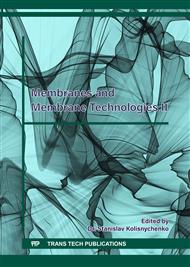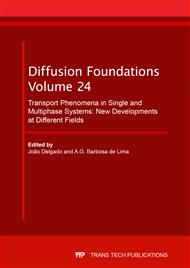[1]
E. Frederic,C.Guigui, M.Jacob, C.Machinal,A.Krifi,A. Line,Schmitz, P. Modelling of fluid flow distribution in multichannel ceramic membrane: Application to the filtration of produced water, Journal of Membrane Science. 567, 1 (2018) 290-302.
DOI: 10.1016/j.memsci.2018.09.021
Google Scholar
[2]
A. dos S.Barbosa, A.dos S.Barbosa, T. L. A.Barbosa, M. G. F. Rodrigues, Synthesis of zeolite membrane (NaY/alumina): Effect of precursor of ceramic support and its application in the process of oil-water separation, Separation and Purification Technology. 200(2018) 141-154.
DOI: 10.1016/j.seppur.2018.02.001
Google Scholar
[3]
T.V. Mota, H.G. Alves, S.R. Farias Neto, A.G.B. Lima, Oily Water Treatment Using Ceramic Membrane in Presence of Swirling Flow Induced by a Tangential Inlet via CFD, Defect and Diffusion Forum. 348 (2014) 51-57.
DOI: 10.4028/www.scientific.net/ddf.348.51
Google Scholar
[4]
H. L. F. Magalhães, A. G. B. Lima, S. R. Farias Neto, H.G. Alves, J. S. Souza, Produced water treatment by ceramic membrane: A numerical investigation by computational fluid dynamics, Advances in Mechanical Engineering. 9, 3(2017) 1-20.
DOI: 10.1177/1687814016688642
Google Scholar
[5]
A. Agi, R. Junin, A.Y. M. Alqatta, A. Gbadamosi, A. Yahya, A. Abbas, Ultrasonic assisted ultrafiltration process for emulsification of oil field produced water treatment, Ultrasonics Sonochemistry.51 (2019) 214-222.
DOI: 10.1016/j.ultsonch.2018.10.023
Google Scholar
[6]
H.Lotfiyan, F. Z.Ashtiani, A.Fouladitajar,S. B. Armand, Computational fluid dynamics modeling and experimental studies of oil-in-water emulsion microfiltration in a flat sheet membrane using Eulerian approach, Journal of Membrane Science. 472, 15 (2014) 1-9.
DOI: 10.1016/j.memsci.2014.08.036
Google Scholar
[7]
D. A.Masciola, R. C.Viadero Jr, B. E. Reed, Tubular ultrafiltration flux prediction for oil-in-water emulsions: analysis of series resistances, Journal of Membrane Science. 184 (2001)197–208.
DOI: 10.1016/s0376-7388(00)00625-6
Google Scholar
[8]
M.Zare, F. Z.Ashtiani, A. Fouladitajar, CFD modeling and simulation of concentration polarization in microfiltration of oil-water emulsions; Application of an Eulerian multiphase model, Desalination. 324(2013) 37-47.
DOI: 10.1016/j.desal.2013.05.022
Google Scholar
[9]
K.Damak, A.Ayadi, B.Zeghmati, P.Schmitz, New Navier-Stokes and Darcy's law combined model for fluid flow in cross-flow filtration tubular membranes, Desalination. 161, 1(2004) 67-77.
DOI: 10.1016/s0011-9164(04)90041-0
Google Scholar
[10]
H. L. F. Magalhães, A. G. B. Lima, S. R. de Farias Neto, A. F. de Almeida, T. H. F. de Andrade, V. A. A. Brandão,Ceramic Membranes: Theory and Engineering Applications, Advanced Structured Materials. 1ed.Heidelberg (Germany): Springer International Publishing, vol. 93, 2018, pp.111-137.
DOI: 10.1007/978-3-319-91062-8_4
Google Scholar
[11]
F. P. Incropera, D. P. Dewitt, T. L. Bergman, A.S. Lavine,Fundamentals of heat and mass transfer, 7st Ed., Acid-free paper, United States of America, (2007).
Google Scholar
[12]
V. S. Minnikanti, S. Dasgupta, S. De, Prediction of mass transfer coefficient with suction for turbulent flow in cross flow ultrafiltration, Journal of Membrane Science. 154, 2(1999) 227-239.
DOI: 10.1016/s0376-7388(98)00371-8
Google Scholar
[13]
K. Damak, A. Ayadi, B. Zeghmati, P. Schmitz, Concentration polarisation in tubular membranes - a numerical approach, Desalination.171, 2 (2004) 139-153.
DOI: 10.1016/j.desal.2004.05.002
Google Scholar
[14]
A. K. Coker, Ludwig's applied process design for chemical and petrochemical plant, 4ª edition. United States: Gulf Professional Publishing, vol. 2, (2010).
Google Scholar
[15]
M. L. V. Ramires, C. A. N. Castro, A. Nagashima, M. J. Assael, W. A. Wakeham, Standard reference data for the thermal conductivity of water, Journal of Physics and Thermophysics. 33, 3(1977) 925-929.
Google Scholar
[16]
A. L. Cunha, Treatment of effluents from the petroleum industry via ceramic membranes: Modeling and simulation, Doctoral Thesis in Process Engineering, Federal University of Campina Grande, Campina Grande, Brazil, 201p., (2014). (In Portuguese).
DOI: 10.21475/ajcs.2016.10.10.p7455
Google Scholar
[17]
K. Damak, A. Ayadi, P. Schmitz, B. Zeghmati, Modeling of cross-flow membrane separation processes under laminar flow conditions in tubular membrane, Desalination. 168 (2004) 231-239.
DOI: 10.1016/j.desal.2004.07.003
Google Scholar



